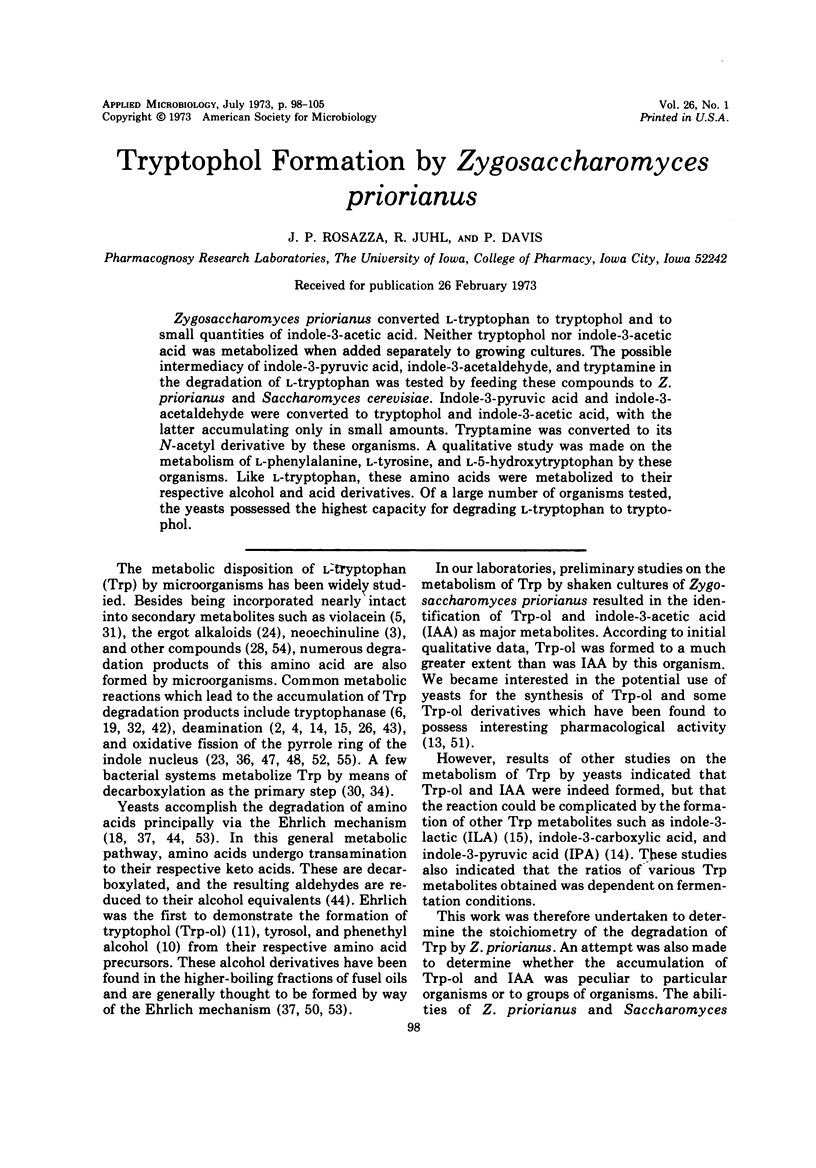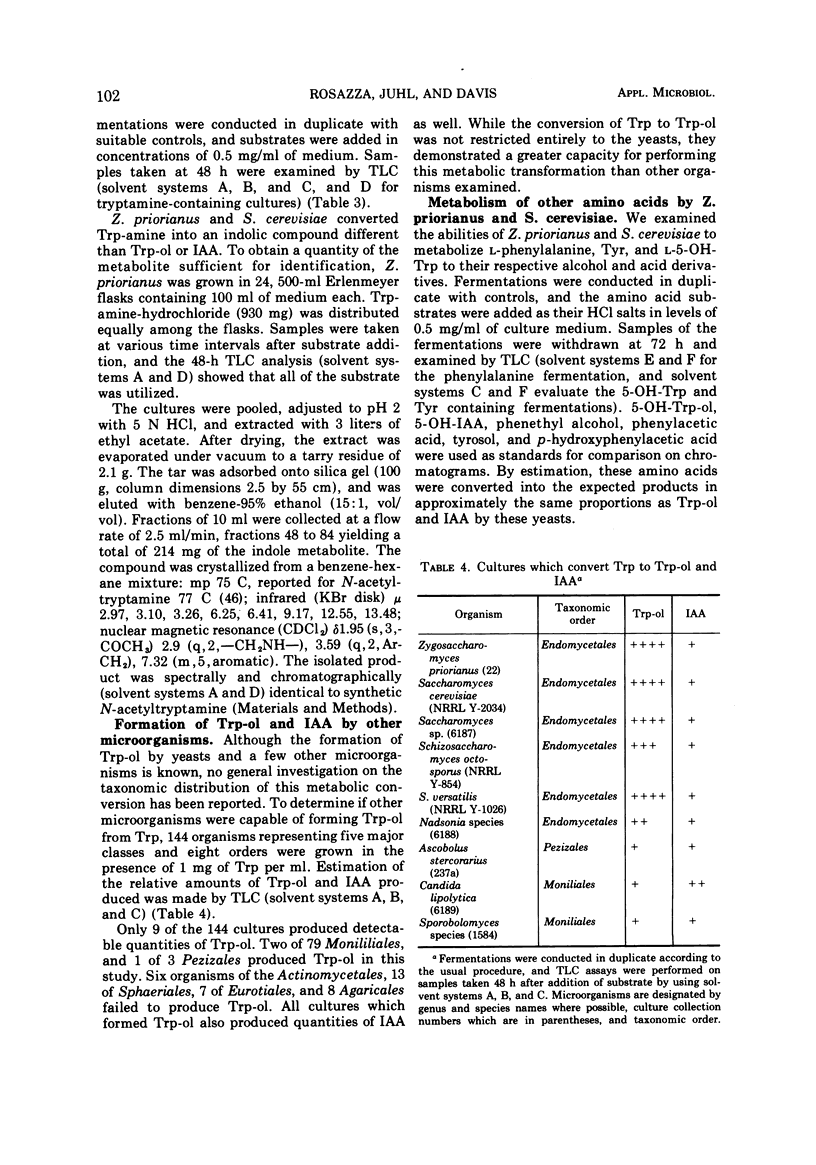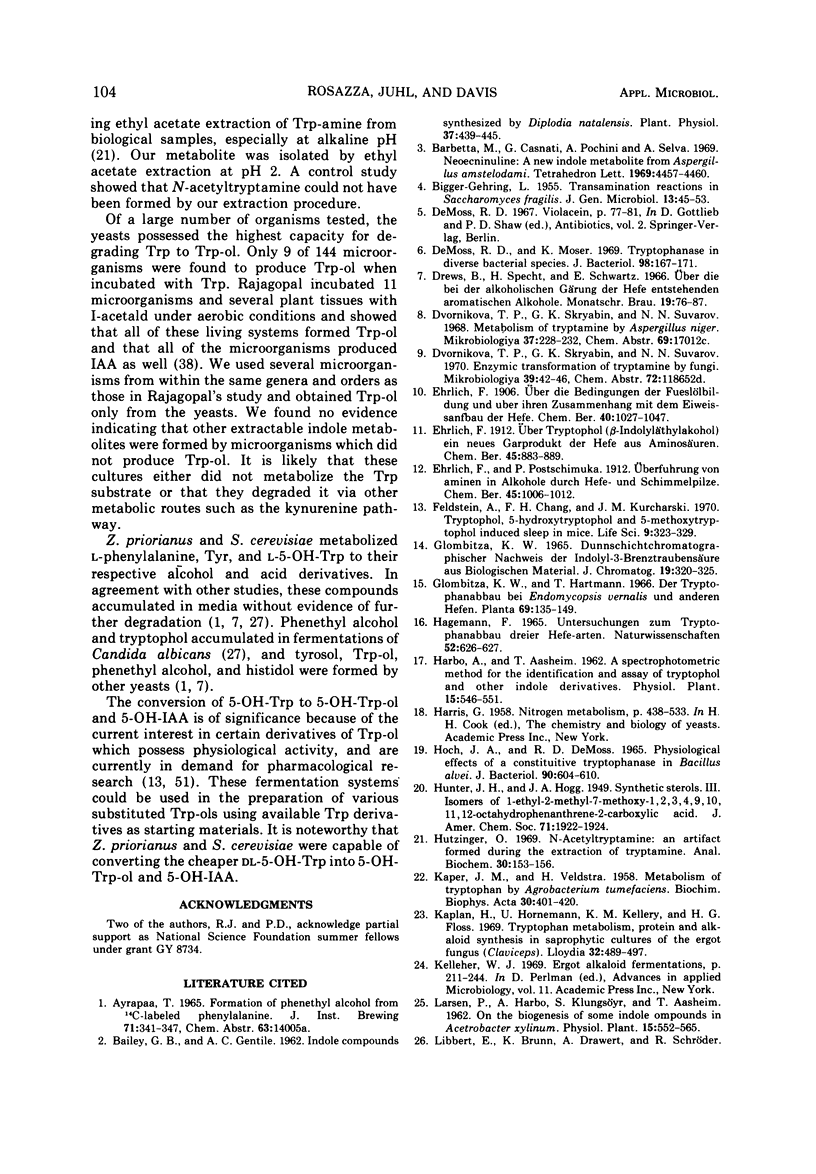Abstract
Zygosaccharomyces priorianus converted L-tryptophan to tryptophol and to small quantities of indole-3-acetic acid. Neither tryptophol nor indole-3-acetic acid was metabolized when added separately to growing cultures. The possible intermediacy of indole-3-pyruvic acid, indole-3-acetaldehyde, and tryptamine in the degradation of L-tryptophan was tested by feeding these compounds to Z. priorianus and Saccharomyces cerevisiae. Indole-3-pyruvic acid and indole-3-acetaldehyde were converted to tryptophol and indole-3-acetic acid, with the latter accumulating only in small amounts. Tryptamine was converted to its N-acetyl derivative by these organisms. A qualitative study was made on the metabolism of L-phenylalanine, L-tyrosine, and L-5-hydroxytryptophan by these organisms. Like L-tryptophan, these amino acids were metabolized to their respective alcohol and acid derivatives. Of a large number of organisms tested, the yeasts possessed the highest capacity for degrading L-tryptophan to tryptophol.
Full text
PDF







Selected References
These references are in PubMed. This may not be the complete list of references from this article.
- BIGGER-GEHRING L. Transamination reactions in Saccharomyces fragilis. J Gen Microbiol. 1955 Aug;13(1):45–53. doi: 10.1099/00221287-13-1-45. [DOI] [PubMed] [Google Scholar]
- Bailey G. B., Gentile A. C. Indole Compounds Synthesized by Diplodia natalensis. Plant Physiol. 1962 May;37(3):439–445. doi: 10.1104/pp.37.3.439. [DOI] [PMC free article] [PubMed] [Google Scholar]
- DeMoss R. D., Moser K. Tryptophanase in diverse bacterial species. J Bacteriol. 1969 Apr;98(1):167–171. doi: 10.1128/jb.98.1.167-171.1969. [DOI] [PMC free article] [PubMed] [Google Scholar]
- Feldstein A., Chang F. H., Kucharski J. M. Tryptophol, 5-hydroxytryptophol and 5-methoxytryptophol induced sleep in mice. Life Sci. 1970 Mar 15;9(6):323–329. doi: 10.1016/0024-3205(70)90220-1. [DOI] [PubMed] [Google Scholar]
- Glombitza K. W. Dünnschichtchromatographischer Nachweis der Indolyl-3-brenztraubensäure aus biologischem Material. J Chromatogr. 1965 Aug;19(2):320–325. doi: 10.1016/s0021-9673(01)99466-x. [DOI] [PubMed] [Google Scholar]
- Hoch J. A., Demoss R. D. Physiological Effects of a Constitutive Tryptophanase in Bacillus alvei. J Bacteriol. 1965 Sep;90(3):604–610. doi: 10.1128/jb.90.3.604-610.1965. [DOI] [PMC free article] [PubMed] [Google Scholar]
- Hutzinger O. N-acetyltryptamine: an artifact formed during the extraction of tryptamine. Anal Biochem. 1969 Jul;30(1):153–156. doi: 10.1016/0003-2697(69)90384-4. [DOI] [PubMed] [Google Scholar]
- KAPER J. M., VELDSTRA H. On the metabolism of tryptophan by Agrobacterium tumefaciens. Biochim Biophys Acta. 1958 Nov;30(2):401–420. doi: 10.1016/0006-3002(58)90065-9. [DOI] [PubMed] [Google Scholar]
- Kaplan H., Hornemann U., Kelley K. M., Floss H. G. Tryptophan metabolism, protein and alkaloid synthesis in saprophytic cultures of the ergot fungus (Claviceps sp.). Lloydia. 1969 Dec;32(4):489–497. [PubMed] [Google Scholar]
- Kelleher W. J. Ergot alkaloid fermentations. Adv Appl Microbiol. 1969;11:211–244. doi: 10.1016/s0065-2164(08)70611-7. [DOI] [PubMed] [Google Scholar]
- Lingappa B. T., Prasad M., Lingappa Y., Hunt D. F., Biemann K. Phenethyl alcohol and tryptophol: autoantibiotics produced by the fungus Candida albicans. Science. 1969 Jan 10;163(3863):192–194. doi: 10.1126/science.163.3863.192. [DOI] [PubMed] [Google Scholar]
- MITOMA C., UNDENFRIEND S. Bacterial tryptophan decarboxylase. Biochim Biophys Acta. 1960 Jan 15;37:356–357. doi: 10.1016/0006-3002(60)90249-3. [DOI] [PubMed] [Google Scholar]
- MITOMA C., WEISSBACH H., UDENFRIEND S. 5-Hydroxytryptophan formation and tryptophan metabolism in Chromobacterium violaceum. Arch Biochem Biophys. 1956 Jul;63(1):122–130. doi: 10.1016/0003-9861(56)90016-9. [DOI] [PubMed] [Google Scholar]
- Nakazawa H., Enei H., Okumura S., Yoshida H., Yamada H. Enzymatic preparation of L-tryptophan and 5-hydroxy-L-tryptophan. FEBS Lett. 1972 Sep 1;25(1):43–45. doi: 10.1016/0014-5793(72)80449-6. [DOI] [PubMed] [Google Scholar]
- Perley J. E., Stowe B. B. The production of tryptamine from tryptophan by Bacillus cereus (KVT). Biochem J. 1966 Jul;100(1):169–174. doi: 10.1042/bj1000169. [DOI] [PMC free article] [PubMed] [Google Scholar]
- Pillay D. T., Mehdi R. Separation of simple indole derivatives by thin layer chromatography. J Chromatogr. 1968 Feb 6;32(3):592–595. doi: 10.1016/s0021-9673(01)80535-5. [DOI] [PubMed] [Google Scholar]
- Prasad C., Srinivasan V. R. Tryptophan catabolism during sporulation in Bacillus cereus. Biochem J. 1970 Sep;119(2):343–349. doi: 10.1042/bj1190343. [DOI] [PMC free article] [PubMed] [Google Scholar]
- Roth C. W., Hoch J. A., DeMoss R. D. Physiological studies of biosynthetic indole excretion in Bacillus alvei. J Bacteriol. 1971 Apr;106(1):97–106. doi: 10.1128/jb.106.1.97-106.1971. [DOI] [PMC free article] [PubMed] [Google Scholar]
- SENTHESHANMUGANATHAN S., ELSDEN S. R. The mechanism of the formation of tyrosol by Saccharomyces cerevisiae. Biochem J. 1958 Jun;69(2):210–218. doi: 10.1042/bj0690210. [DOI] [PMC free article] [PubMed] [Google Scholar]
- SENTHESHANMUGANATHAN S. The purification and properties of the tyrosine-2-oxoglutarate transaminase of Saccharomyces cerevisiae. Biochem J. 1960 Dec;77:619–625. doi: 10.1042/bj0770619. [DOI] [PMC free article] [PubMed] [Google Scholar]
- STANIER R. Y., HAYAISHI O., TSUCHIDA M. The bacterial oxidation of tryptophan. I. A general survey of the pathways. J Bacteriol. 1951 Oct;62(4):355–366. doi: 10.1128/jb.62.4.355-366.1951. [DOI] [PMC free article] [PubMed] [Google Scholar]
- STANIER R. Y., HAYAISHI O. The bacterial oxidation of tryptophan; a study in comparative biochemistry. Science. 1951 Sep 28;114(2961):326–330. doi: 10.1126/science.114.2961.326. [DOI] [PubMed] [Google Scholar]
- Stoessl A., Venis M. A. Determination of submicrogram levels of indole-3-acetic acid: a new, highly specific method. Anal Biochem. 1970 Apr;34(2):344–351. doi: 10.1016/0003-2697(70)90118-1. [DOI] [PubMed] [Google Scholar]
- Taborsky R. G. 5-hydroxytryptophol: evidence for its having physiological properties. Experientia. 1971 Aug;27(8):929–930. doi: 10.1007/BF02135750. [DOI] [PubMed] [Google Scholar]


